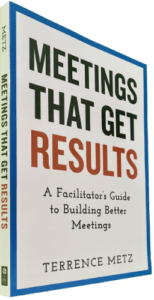Sometimes meetings that look promising before they begin, fail unexpectedly. Four primary causes of meeting failures deserve your attention. They sneak up on groups, ill-prepared to anticipate or mitigate them. Participants need your awareness about these meeting failures as their meeting leader and facilitator.
First Cause of Meeting Failures: The Problem with Solving
First, what is a “promising meeting”? When the session leader has confirmed a solid and necessary deliverable from the meeting participants but fails to develop an appropriate method or agenda, most meetings will flounder or fail. North Americans, in particular, are subject to an “over-confidence” bias. They show up expecting to develop the right method, ask the right questions, or conduct the appropriate analysis “on the fly”. Some have called this meeting syndrome, “solving”. “Solving” dominates the causes of meeting failures.
Second Cause of Meeting Failures: Over-confidence bias

Meeting Failure Causes
The same over-confidence bias causes many to skip the analysis and jump immediately from the problem to the solution. As a result, they frequently ask pertinent but impossible questions akin to “How do you solve global hunger?” or “How do you boil the ocean?”. While the participants may have a vested interest in solving the hunger issue or resolving a technical issue, the session leader has not made it easy for them to arrive at a consensual solution because the method has failed to break it down into manageable pieces.
Third Cause of Meeting Failures: Question Precision
One of the surest ways to get a group of vested participants to go silent is to ask a meaningful question that is so broad as to be unanswerable.
Participants become numb about how to respond. Note the “hunger” problem as an example. Hunger remains a function of food development, food distribution, food storage, nutrition absorption, etc. By narrowing the scope a bit and providing a focused question, a facilitator can make it a lot easier for a group to respond, such as “How could we improve food storage capacity in Somalia?” With a precise question, and narrower scope (i.e., Somalia versus the entire world), it becomes much easier to provide answers such as “converts those old rail cars” or “use the abandoned mine shafts”.
Fourth Cause of Meeting Failures: Question Sequencing
Not only should the overriding question be broken into discrete questions, but the questions need to be sequenced as well. For example, the big question “So, what is the marketing plan for 20xx?” is better served with discrete discussions around segmentation, targeting, positioning, messaging, media, etc. Most marketing experts suggest identifying the target audience before going further into the analysis or plan development.
Likewise, when building a home, a residential architect needs to know “What color do you want the grout to be in the secondary bathroom?” That type of question, however, while demanding an answer, is probably best saved for the end of development, after agreeing on the purpose of the home, location, size, traffic flow, etc. These additional topical areas become natural agenda steps that increase the robustness of the method behind the meeting, also known as an agenda.
No one wants another meeting, especially a non-productive session.
To ensure that your meetings are anticipated, respected, and more productive than the meeting your participants came from or the meeting they are headed to next, embrace the following suggestions to correct why meetings fail.

Meetings Fail — Here’s How to Stop It
Start on Time
Do not penalize people who are on time by waiting for people who are late. Few irritants get a meeting started poorly than a wavering start time. Ask participants to notify you in advance if they might be late. If they arrive late, do NOT consume others’ time by reviewing what has transpired. Instead, pair them off with someone else and ask them to go in the hallway to provide an update.
Document
If it was not documented then it did not happen. Meetings without documentation suggest that nothing worthwhile happened. Optimally, add context and rationale for all topics and decisions made. Take any decision to a steering team or decision review board and their first challenge will be “Why?” Carefully leave a paper trail for the reasons.
Time Sensitivity
While participants should typically share a few laughs, real meeting success is judged by finishing on time, or better yet, ahead of schedule. Be careful about taking on strategic issues during a brief meeting, they should be logged and set aside for a longer forum. Do not allow participants to go into too much detail, that others find irrelevant. They can build and provide concrete details on their own. Remember too, that ‘standing’ meetings (i.e., meetings held regularly at the same time every week) were originally intended for participants to stand and not sit. By the way, ‘standing’ meetings are completed much faster than ‘sitting’ meetings.
Agenda Control
Stay vigilant about following the agenda. In other words, stay in scope. Sometimes arguments about the project, the organization, or other issues beyond control dominate a meeting. Participants talk about what they want to give rise to the concept of people “who have their own agenda.” Stick to your agenda and monitor progress carefully.
Visual Support
Stimulate participants and discussion with the proper use of easels and supplementary visuals. Do not however rely on a deck of slides. People can read and challenge slide decks on their own, they do not need a meeting for that. Build slides that share causal links and supplement them with visuals that stimulate. A visually dynamic meeting offers ‘sex appeal’ compared to others.
Secure Feedback
Get an audible agreement, beginning with ground rules. Document decision points, preferably on large-scale poster-size paper or whiteboards. As you build consensus, emphasize that consensus implies a quality decision that ALL participants can support, but NOT one that necessarily makes everyone happy. Consensus is something they can live with, and not disrupt in the hallways after the meeting.
Careful Review
Upon conclusion, carefully review and confirm that everyone understands the next steps. If the meeting changes nothing, why meet? Make the change or assignments visible and consider using a RASI chart for support. For any and all follow-up meeting(s), confirm future dates, times, and locations. Most importantly, conclude on time, or preferably, early. Before they depart, secure additional feedback on what you could have done to make the meeting even more successful. For solid and anonymous feedback, use our Post-it© note approach combined with the T-chart called Plus-Delta. They provide more meaningful input than offered openly in public. Participants do not want to “embarrass” you with their criticism.
Why do meetings fail? By following the suggestions above you can circumvent the three most common complaints about meetings, namely:
- Disorganized (i.e., uncertain output or outcome)
- Length (ie, wasted time)
- Predetermined decisions (meetings are a poor form of persuasion)
Convert Why Meetings Fail Into Meeting Success
The lesson to be learned? Break it down. Speak with experts and study additional reference material. Take any significant reason or question behind a meeting and determine the various questions that could be answered in support. Find the natural groupings and create a topical flow. Now you have at least a basic agenda that will help prevent you from asking such a broad question that it could lead to meeting silence or even failure.
______
Don’t ruin your career by hosting bad meetings. Sign up for a workshop or send this to someone who should. MGRUSH workshops focus on meeting design and practice. Each person practices tools, methods, and activities every day during the week. Therefore, while some call this immersion, we call it the road to building high-value facilitation skills.
Our workshops also provide a superb way to earn up to 40 SEUs from the Scrum Alliance, 40 CDUs from IIBA, 40 Continuous Learning Points (CLPs) based on Federal Acquisition Certification Continuous Professional Learning Requirements using Training and Education activities, 40 Professional Development Units (PDUs) from SAVE International, as well as 4.0 CEUs for other professions. (See workshop and Reference Manual descriptions for details.)
Want a free 10-minute break timer? Sign up for our once-monthly newsletter HERE and receive a timer along with four other of our favorite facilitation tools, free.

Terrence Metz, president of MG RUSH Facilitation Training, was just 22-years-old and working as a Sales Engineer at Honeywell when he recognized a widespread problem—most meetings were ineffective and poorly led, wasting both time and company resources. However, he also observed meetings that worked. What set them apart? A well-prepared leader who structured the session to ensure participants contributed meaningfully and achieved clear outcomes.
Throughout his career, Metz, who earned an MBA from Kellogg (Northwestern University) experienced and also trained in various facilitation techniques. In 2004, he purchased MG RUSH where he shifted his focus toward improving established meeting designs and building a curriculum that would teach others how to lead, facilitate, and structure meetings that drive results. His expertise in training world-class facilitators led to the 2020 publication of Meetings That Get Results: A Guide to Building Better Meetings, a comprehensive resource on effectively building consensus.
Grounded in the principle that “nobody is smarter than everybody,” the book details the why, what, and how of building consensus when making decisions, planning, and solving problems. Along with a Participant’s Guide and supplemental workshops, it supports learning from foundational awareness to professional certification.
Metz’s first book, Change or Die: A Business Process Improvement Manual, tackled the challenges of process optimization. His upcoming book, Catalyst: Facilitating Innovation, focuses on meetings and workshops that don’t simply end when time runs out but conclude with actionable next steps and clear assignments—ensuring progress beyond discussions and ideas.



Fastidious response with real arguments explaining the supporting rationale.
Much appreciated Baily.